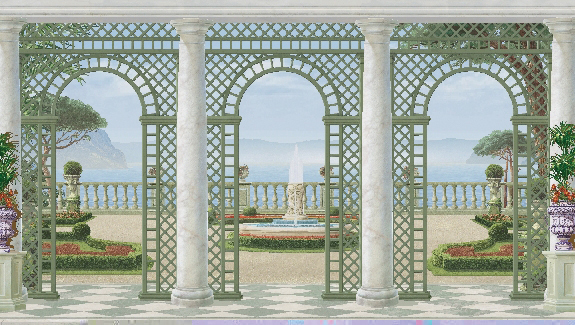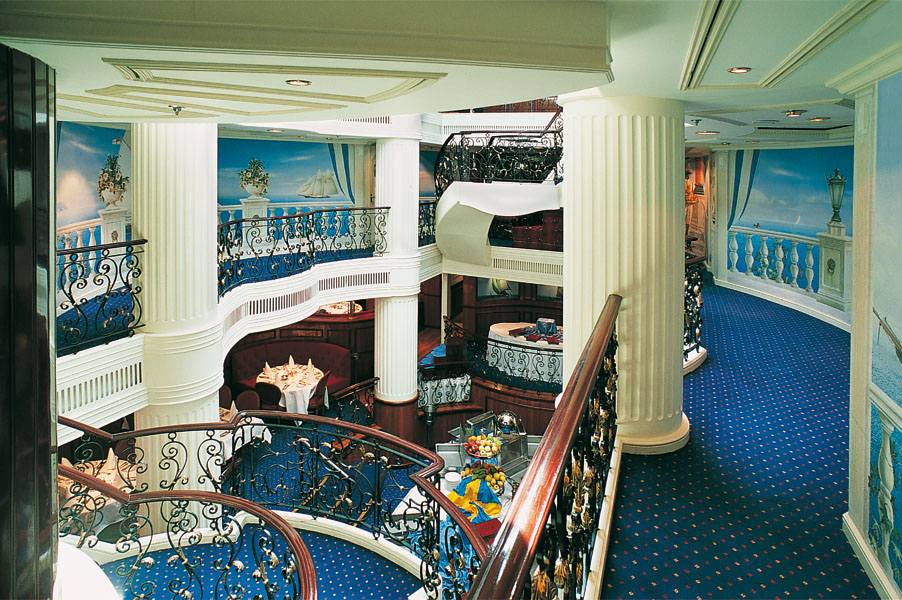Frescography on:
[Wikipedia]
[Google]
[Amazon]
Frescography (from 
 Unlike
Unlike 
 Frescographies can be found in the Lanner Lehar Hall of the Vienna town hall or the world's largest cruising ship, ''
Frescographies can be found in the Lanner Lehar Hall of the Vienna town hall or the world's largest cruising ship, ''
Virtual Design Studio
AmourPrints
Printing software Printmaking Decorative arts
Latin
Latin (, or , ) is a classical language belonging to the Italic branch of the Indo-European languages. Latin was originally a dialect spoken in the lower Tiber area (then known as Latium) around present-day Rome, but through the power of the ...
''fresco'' – ''painting onto "fresh" plaster'' + Greek
Greek may refer to:
Greece
Anything of, from, or related to Greece, a country in Southern Europe:
*Greeks, an ethnic group.
*Greek language, a branch of the Indo-European language family.
**Proto-Greek language, the assumed last common ancestor ...
''graphein'' - to write) is a method for producing murals digitally on paper, canvas, glass or tiles, invented in 1998 by German muralist Rainer Maria Latzke. Frescography uses CAM
Calmodulin (CaM) (an abbreviation for calcium-modulated protein) is a multifunctional intermediate calcium-binding messenger protein expressed in all eukaryotic cells. It is an intracellular target of the secondary messenger Ca2+, and the bin ...
and digital printing
Digital printing is a method of printing from a digital-based image directly to a variety of media. It usually refers to professional printing where small-run jobs from desktop publishing and other digital sources are printed using large-format ...
methods to create murals.

History of mural reproduction techniques
The frescography is based on a similar technique as thewoodblock printing
Woodblock printing or block printing is a technique for printing text, images or patterns used widely throughout East Asia and originating in China in antiquity as a method of textile printing, printing on textiles and later paper. Each page o ...
method of the French Papier Peints wallpapers, used by manufacturers like Zuber et cie or Joseph Dufour et Cie, who began developing the procedure during the end of the 18th century. These wallpaper
Wallpaper is a material used in interior decoration to decorate the interior walls of domestic and public buildings. It is usually sold in rolls and is applied onto a wall using wallpaper paste. Wallpapers can come plain as "lining paper" (so ...
manufacturers used thousands of engraved woodblocks for the creation of the panorama sceneries, to create wall paper such as the 20-panel Sauvages de la Mer du Pacifique which Jean-Gabriel Charvet
Jean-Gabriel Charvet (1750–1829), also known as Jean Gabriel Charvet, was a French painter, designer and draftsman who was born in Serrières, Ardèche, France. He studied at the École de Dessin in Lyon under the French artist Donat Nonnotte ( ...
designed for Joseph Dufour et Cie or the “du Vue de l'Amérique Nord” designed in 1834 by Zuber et cie for the Diplomatic Reception Room
The Diplomatic Reception Room is one of three oval rooms in the Executive Residence of the White House, the official home of the president of the United States. It is located on the ground floor and is used as an entrance from the South Lawn, ...
of the White House
The White House is the official residence and workplace of the president of the United States. It is located at 1600 Pennsylvania Avenue NW in Washington, D.C., and has been the residence of every U.S. president since John Adams in ...
, where it is still today.
The principle of frescography
 Unlike
Unlike woodblock printing
Woodblock printing or block printing is a technique for printing text, images or patterns used widely throughout East Asia and originating in China in antiquity as a method of textile printing, printing on textiles and later paper. Each page o ...
, the frescography is based on digitally cut-out motifs which are stored in a database
In computing, a database is an organized collection of data stored and accessed electronically. Small databases can be stored on a file system, while large databases are hosted on computer clusters or cloud storage. The design of databases s ...
. To avoid having to work with high-resolution files on software such as Photoshop
Adobe Photoshop is a raster graphics editor developed and published by Adobe Inc. for Windows and macOS. It was originally created in 1988 by Thomas and John Knoll. Since then, the software has become the industry standard not only in raster ...
(resulting in long rendering and processing time), new CAM
Calmodulin (CaM) (an abbreviation for calcium-modulated protein) is a multifunctional intermediate calcium-binding messenger protein expressed in all eukaryotic cells. It is an intracellular target of the secondary messenger Ca2+, and the bin ...
software programs like the Dreamworlds Design Studio allow the composition of mural designs by working with preview files which are later converted to the original resolution. By adding the exact measurements of a wall when starting a new project and even taking architectural elements such as doors windows or beams into consideration, the design will result in an accurately and tailor-fit wall mural.
Once a design is finished, the low-resolution motifs are converted into the original high-resolution images and are printed on wide-format printer
Wide format printers (large format printers) are generally accepted to be any computer-controlled printing machines (printers) that support a maximum print roll width of between {{Convert, 18 and 100, in. Printers with capacities over 100 in w ...
s. Unlike the woodblock print consisting of stripes, the frescography is printed on a single piece of
canvas, allowing a seamless mural tailor-fit to the walls dimensions. Once produced, the canvas is applied to the wall in a wall-paper-like procedure.
Since the motifs can be placed freely and scaled to the individual wall measurements, the finished piece will look like it was created on-site.

Institute of Frescography
In 2009 the inventor of the frescography technique, Professor Rainer Maria Latzke, founded theInstitute
An institute is an organisational body created for a certain purpose. They are often research organisations ( research institutes) created to do research on specific topics, or can also be a professional body.
In some countries, institutes ca ...
of Frescography (IOF) at Utah State University
Utah State University (USU or Utah State) is a public land-grant research university in Logan, Utah. It is accredited by the Northwest Commission on Colleges and Universities. With nearly 20,000 students living on or near campus, USU is Utah ...
in Logan, Utah
Utah ( , ) is a state in the Mountain West subregion of the Western United States. Utah is a landlocked U.S. state bordered to its east by Colorado, to its northeast by Wyoming, to its north by Idaho, to its south by Arizona, and to it ...
. The IOF is a non-profit
A nonprofit organization (NPO) or non-profit organisation, also known as a non-business entity, not-for-profit organization, or nonprofit institution, is a legal entity organized and operated for a collective, public or social benefit, in co ...
institution whose mission is the improvement of public knowledge and interest in the art of mural and fresco painting
Painting is the practice of applying paint, pigment, color or other medium to a solid surface (called the "matrix" or "support"). The medium is commonly applied to the base with a brush, but other implements, such as knives, sponges, and ai ...
. It also researches on Art history
Art history is the study of aesthetic objects and visual expression in historical and stylistic context. Traditionally, the discipline of art history emphasized painting, drawing, sculpture, architecture, ceramics and decorative arts; yet today ...
, digital reproduction, printing
Printing is a process for mass reproducing text and images using a master form or template. The earliest non-paper products involving printing include cylinder seals and objects such as the Cyrus Cylinder and the Cylinders of Nabonidus. The ...
processes and materials, and restoration techniques of mural art.
In cooperation with the German Zentralinstitut für Kunstgeschichte, the IOF provides online access to the collection a 40,000 images archive
An archive is an accumulation of historical records or materials – in any medium – or the physical facility in which they are located.
Archives contain primary source documents that have accumulated over the course of an individual or ...
of European wall and mural painting
Painting is the practice of applying paint, pigment, color or other medium to a solid surface (called the "matrix" or "support"). The medium is commonly applied to the base with a brush, but other implements, such as knives, sponges, and ai ...
s which have been compiled in the last years of World War II on direct order of Adolf Hitler to preserve the images for a later reconstruction in case of war damages. It also offers free online access to the institute's “World of Ornaments”: an archive of European wall and mural paintings that covers the period between the Gothic ages to the end of the 19th century. This archive consists of 5,000 motifs based on the two greatest encyclopedic
An encyclopedia (American English) or encyclopædia (British English) is a reference work or compendium providing summaries of knowledge either general or special to a particular field or discipline. Encyclopedias are divided into articles ...
collections of ornaments from the 19th-century chromo-lithographic tradition: Auguste Racinet's L“'Ornement polychrome
Polychrome is the "practice of decorating architectural elements, sculpture, etc., in a variety of colors." The term is used to refer to certain styles of architecture, pottery or sculpture in multiple colors.
Ancient Egypt
Colossal statu ...
Volumes I and II“ from 1875 to 1888 and “M. Dupont-Auberville's L'Ornement des tissus” from 1877.
The IOF also is participating in museum
A museum ( ; plural museums or, rarely, musea) is a building or institution that cares for and displays a collection of artifacts and other objects of artistic, cultural, historical, or scientific importance. Many public museums make thes ...
and exhibition projects of mural and fresco art.
Applications of frescographies
 Frescographies can be found in the Lanner Lehar Hall of the Vienna town hall or the world's largest cruising ship, ''
Frescographies can be found in the Lanner Lehar Hall of the Vienna town hall or the world's largest cruising ship, ''Royal Clipper
''Royal Clipper'' is a steel-hulled five-masted fully rigged tall ship used as a cruise ship. She was redesigned by Robert McFarlane of McFarlane ShipDesign, for Star Clippers Ltd. of Sweden, the same designer behind the cruise company's first tw ...
''.
Material and printers
Since frescography is based on digital printing methods, various materials ranging from canvas, ceramics, or glass to PVC, depending on the material the printer supports. One of the most commonly used materials is Digimura FINO 300gsm. This is mainly due to its fine-grain surface finish, which is ideal for both high-end graphics and art photography. The paper's fine raised rivulets also make it extremely well-suited to frescographies in large spaces and ambient backdrops. Commonly frescographies are printed onWide-format printer
Wide format printers (large format printers) are generally accepted to be any computer-controlled printing machines (printers) that support a maximum print roll width of between {{Convert, 18 and 100, in. Printers with capacities over 100 in w ...
s such as Efi's Vutek printer.{{cite web, url=http://www.efi.com/products/production/superwide/vutek/ , title=Vutek wide-format printer , publisher=Efi.com , date= , accessdate=2013-06-23
References
External links
Virtual Design Studio
AmourPrints
Printing software Printmaking Decorative arts